MICT710 Case Study: Ethical Issues in Telstra's Digital Shift
VerifiedAdded on 2023/06/11
|16
|3924
|496
Case Study
AI Summary
This case study delves into the ethical implications of Telstra's digital disruption, examining the shift from a traditional engineering-based company to a fast-paced digital entity. It analyzes ethical issues arising from Telstra's strategies, including data breaches, user privacy concerns, and the impact of crowdsourcing on employment. The report employs the Doing Ethics Technique (DET) framework to assess the ethical dilemmas and proposes recommendations for addressing them. It also explores the potential use of decision support systems and business analytics for competitive advantage, highlighting the importance of IT governance and standards in managing these innovations. The analysis considers the impact on various stakeholders, including Telstra, its customers, and potential cybercriminals, while evaluating the ethical consequences through the lens of IT governance principles.
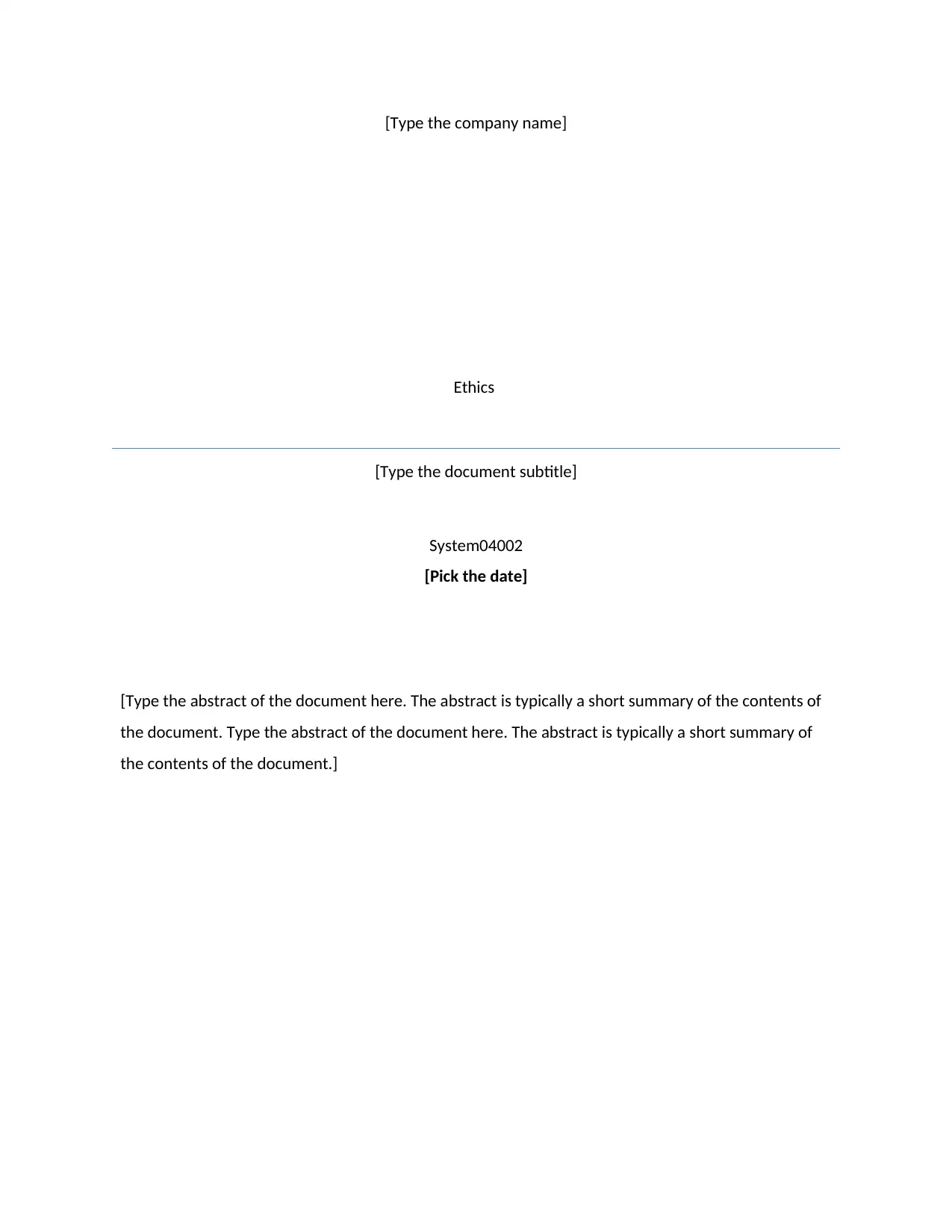
[Type the company name]
Ethics
[Type the document subtitle]
System04002
[Pick the date]
[Type the abstract of the document here. The abstract is typically a short summary of the contents of
the document. Type the abstract of the document here. The abstract is typically a short summary of
the contents of the document.]
Ethics
[Type the document subtitle]
System04002
[Pick the date]
[Type the abstract of the document here. The abstract is typically a short summary of the contents of
the document. Type the abstract of the document here. The abstract is typically a short summary of
the contents of the document.]
Paraphrase This Document
Need a fresh take? Get an instant paraphrase of this document with our AI Paraphraser
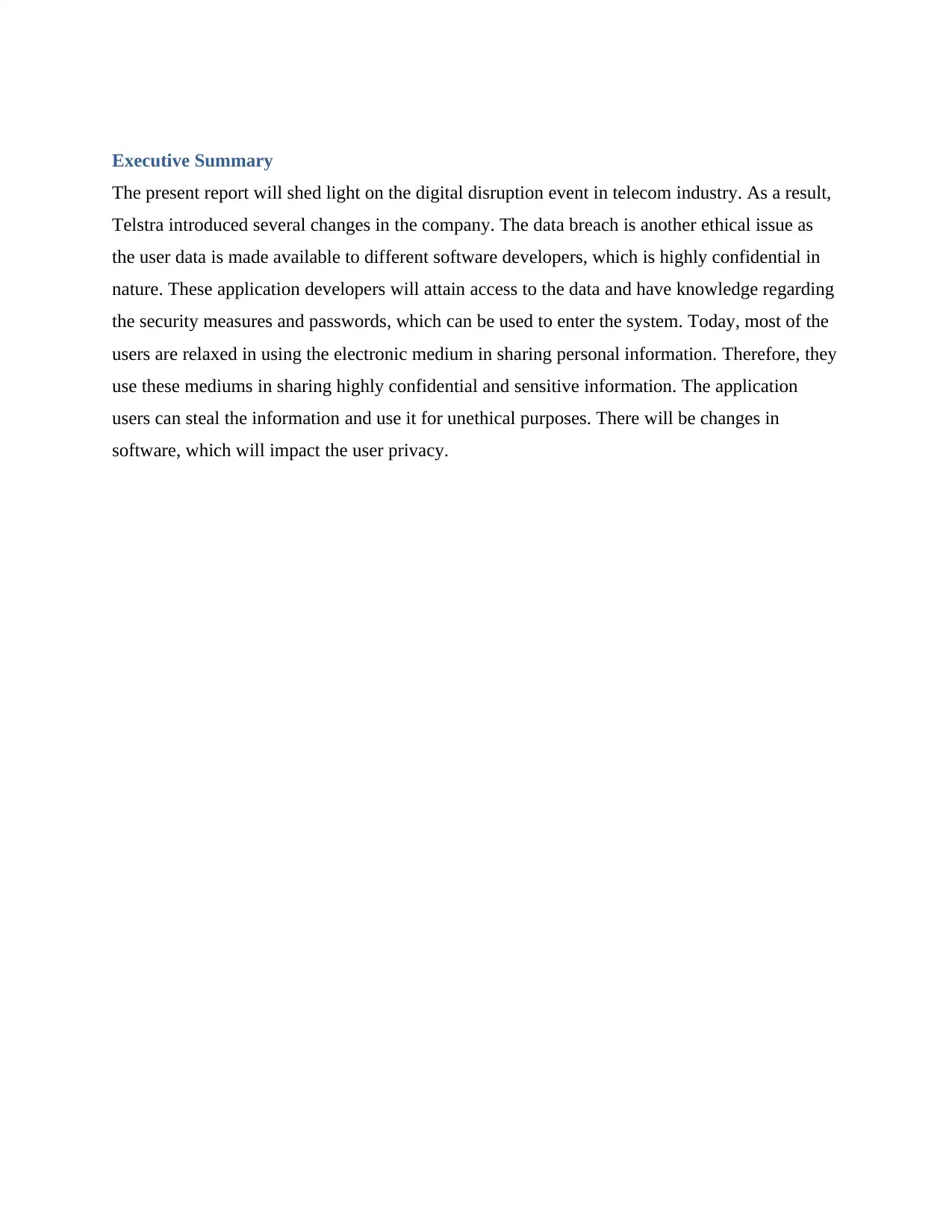
Executive Summary
The present report will shed light on the digital disruption event in telecom industry. As a result,
Telstra introduced several changes in the company. The data breach is another ethical issue as
the user data is made available to different software developers, which is highly confidential in
nature. These application developers will attain access to the data and have knowledge regarding
the security measures and passwords, which can be used to enter the system. Today, most of the
users are relaxed in using the electronic medium in sharing personal information. Therefore, they
use these mediums in sharing highly confidential and sensitive information. The application
users can steal the information and use it for unethical purposes. There will be changes in
software, which will impact the user privacy.
The present report will shed light on the digital disruption event in telecom industry. As a result,
Telstra introduced several changes in the company. The data breach is another ethical issue as
the user data is made available to different software developers, which is highly confidential in
nature. These application developers will attain access to the data and have knowledge regarding
the security measures and passwords, which can be used to enter the system. Today, most of the
users are relaxed in using the electronic medium in sharing personal information. Therefore, they
use these mediums in sharing highly confidential and sensitive information. The application
users can steal the information and use it for unethical purposes. There will be changes in
software, which will impact the user privacy.
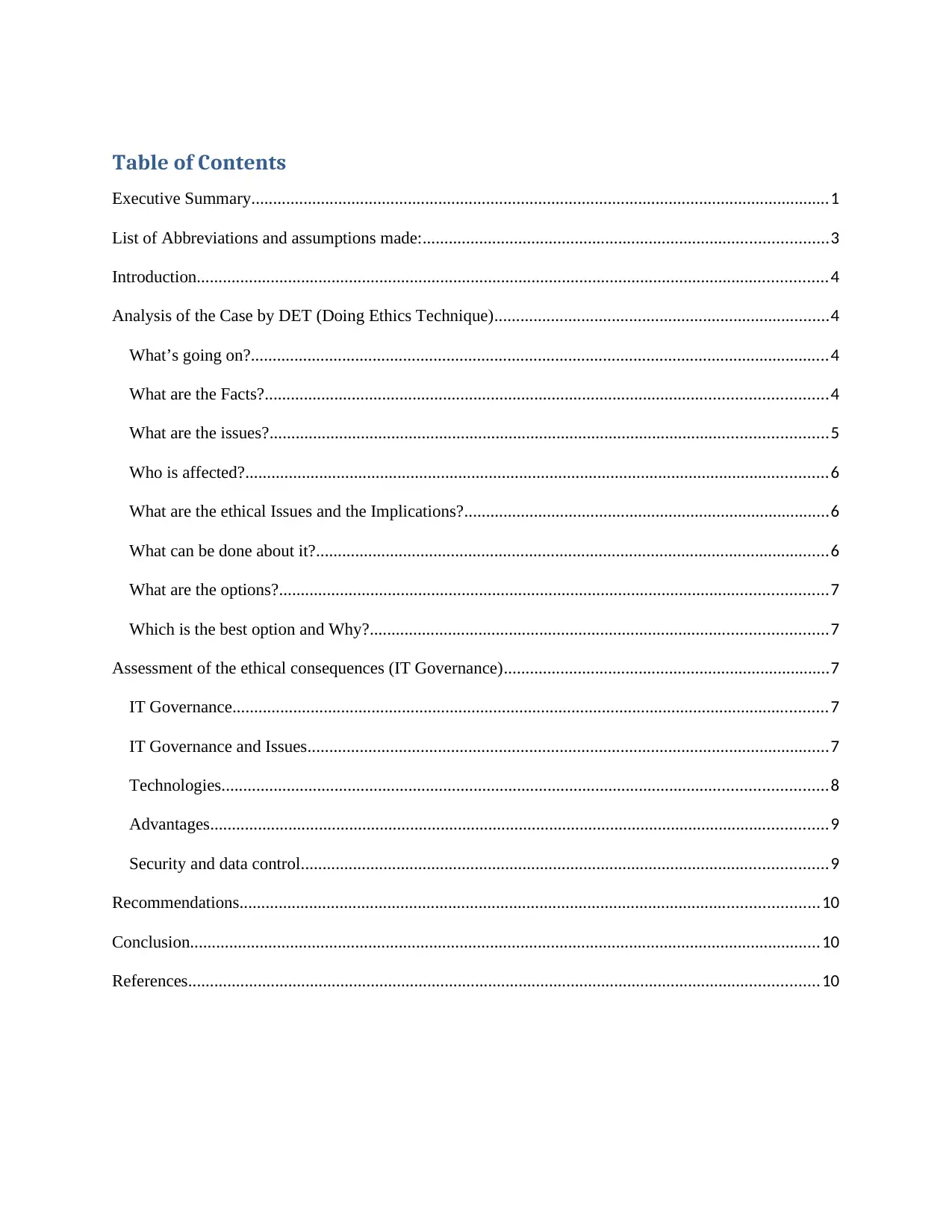
Table of Contents
Executive Summary.....................................................................................................................................1
List of Abbreviations and assumptions made:.............................................................................................3
Introduction.................................................................................................................................................4
Analysis of the Case by DET (Doing Ethics Technique).............................................................................4
What’s going on?.....................................................................................................................................4
What are the Facts?.................................................................................................................................4
What are the issues?................................................................................................................................5
Who is affected?......................................................................................................................................6
What are the ethical Issues and the Implications?....................................................................................6
What can be done about it?......................................................................................................................6
What are the options?..............................................................................................................................7
Which is the best option and Why?.........................................................................................................7
Assessment of the ethical consequences (IT Governance)...........................................................................7
IT Governance.........................................................................................................................................7
IT Governance and Issues........................................................................................................................7
Technologies...........................................................................................................................................8
Advantages..............................................................................................................................................9
Security and data control.........................................................................................................................9
Recommendations.....................................................................................................................................10
Conclusion.................................................................................................................................................10
References.................................................................................................................................................10
Executive Summary.....................................................................................................................................1
List of Abbreviations and assumptions made:.............................................................................................3
Introduction.................................................................................................................................................4
Analysis of the Case by DET (Doing Ethics Technique).............................................................................4
What’s going on?.....................................................................................................................................4
What are the Facts?.................................................................................................................................4
What are the issues?................................................................................................................................5
Who is affected?......................................................................................................................................6
What are the ethical Issues and the Implications?....................................................................................6
What can be done about it?......................................................................................................................6
What are the options?..............................................................................................................................7
Which is the best option and Why?.........................................................................................................7
Assessment of the ethical consequences (IT Governance)...........................................................................7
IT Governance.........................................................................................................................................7
IT Governance and Issues........................................................................................................................7
Technologies...........................................................................................................................................8
Advantages..............................................................................................................................................9
Security and data control.........................................................................................................................9
Recommendations.....................................................................................................................................10
Conclusion.................................................................................................................................................10
References.................................................................................................................................................10
⊘ This is a preview!⊘
Do you want full access?
Subscribe today to unlock all pages.

Trusted by 1+ million students worldwide

Paraphrase This Document
Need a fresh take? Get an instant paraphrase of this document with our AI Paraphraser
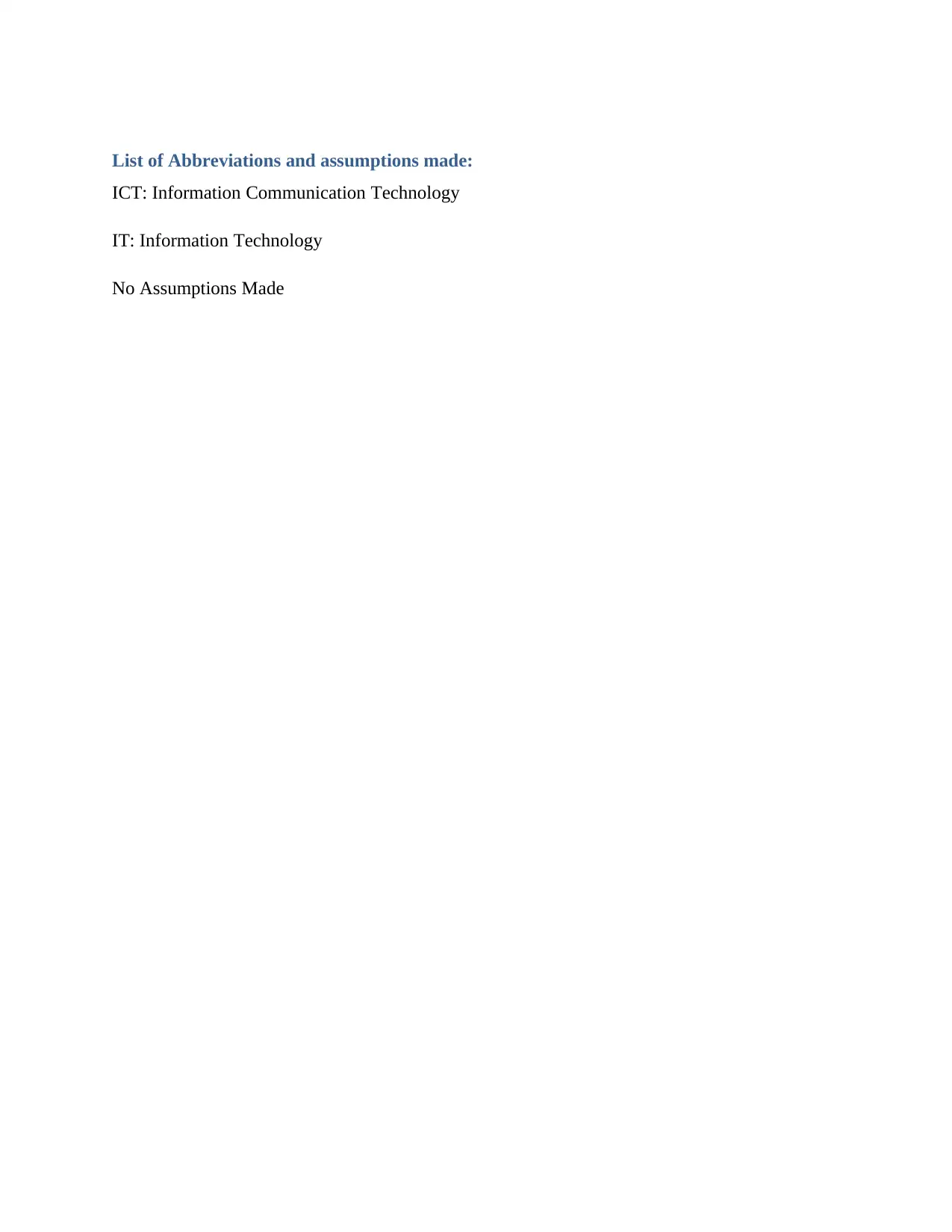
List of Abbreviations and assumptions made:
ICT: Information Communication Technology
IT: Information Technology
No Assumptions Made
ICT: Information Communication Technology
IT: Information Technology
No Assumptions Made
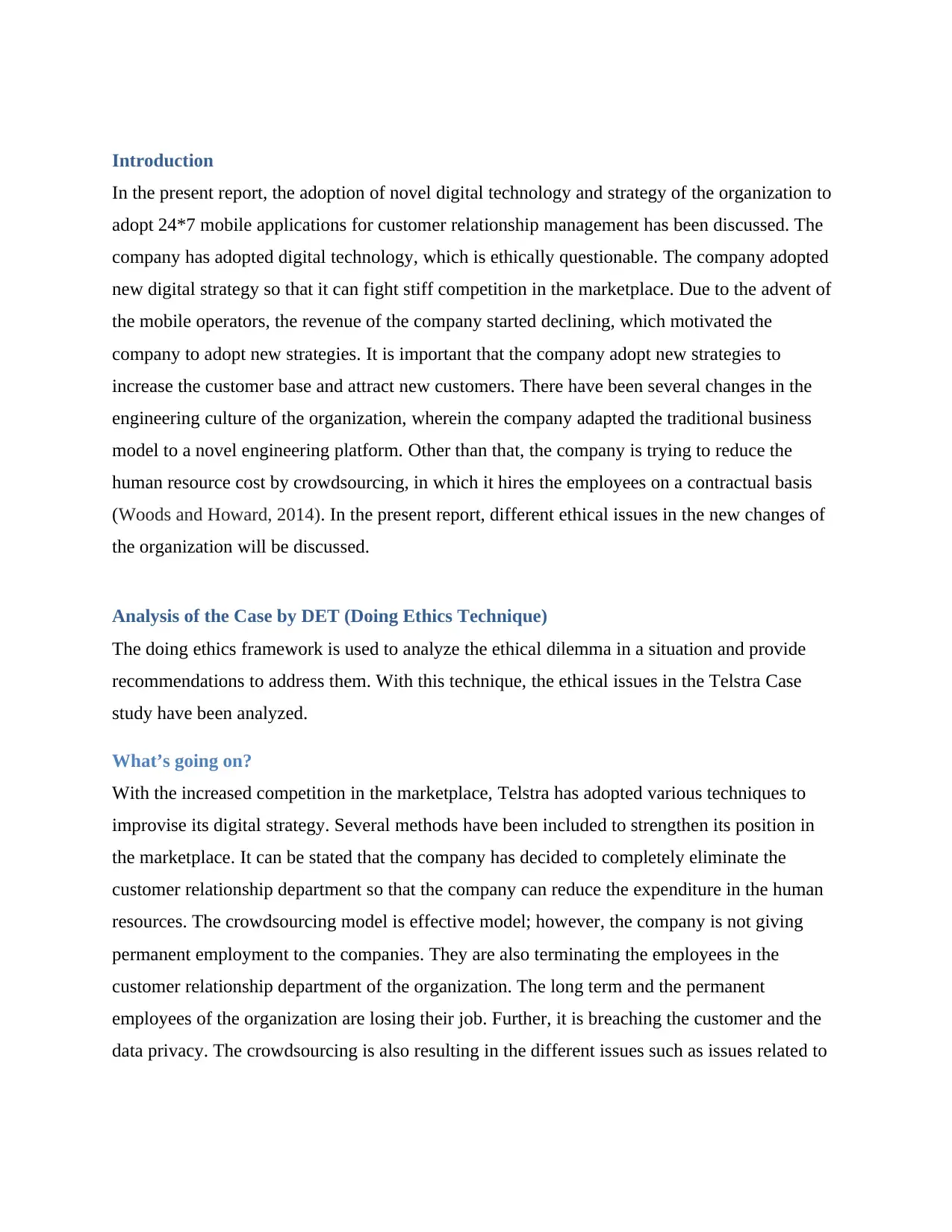
Introduction
In the present report, the adoption of novel digital technology and strategy of the organization to
adopt 24*7 mobile applications for customer relationship management has been discussed. The
company has adopted digital technology, which is ethically questionable. The company adopted
new digital strategy so that it can fight stiff competition in the marketplace. Due to the advent of
the mobile operators, the revenue of the company started declining, which motivated the
company to adopt new strategies. It is important that the company adopt new strategies to
increase the customer base and attract new customers. There have been several changes in the
engineering culture of the organization, wherein the company adapted the traditional business
model to a novel engineering platform. Other than that, the company is trying to reduce the
human resource cost by crowdsourcing, in which it hires the employees on a contractual basis
(Woods and Howard, 2014). In the present report, different ethical issues in the new changes of
the organization will be discussed.
Analysis of the Case by DET (Doing Ethics Technique)
The doing ethics framework is used to analyze the ethical dilemma in a situation and provide
recommendations to address them. With this technique, the ethical issues in the Telstra Case
study have been analyzed.
What’s going on?
With the increased competition in the marketplace, Telstra has adopted various techniques to
improvise its digital strategy. Several methods have been included to strengthen its position in
the marketplace. It can be stated that the company has decided to completely eliminate the
customer relationship department so that the company can reduce the expenditure in the human
resources. The crowdsourcing model is effective model; however, the company is not giving
permanent employment to the companies. They are also terminating the employees in the
customer relationship department of the organization. The long term and the permanent
employees of the organization are losing their job. Further, it is breaching the customer and the
data privacy. The crowdsourcing is also resulting in the different issues such as issues related to
In the present report, the adoption of novel digital technology and strategy of the organization to
adopt 24*7 mobile applications for customer relationship management has been discussed. The
company has adopted digital technology, which is ethically questionable. The company adopted
new digital strategy so that it can fight stiff competition in the marketplace. Due to the advent of
the mobile operators, the revenue of the company started declining, which motivated the
company to adopt new strategies. It is important that the company adopt new strategies to
increase the customer base and attract new customers. There have been several changes in the
engineering culture of the organization, wherein the company adapted the traditional business
model to a novel engineering platform. Other than that, the company is trying to reduce the
human resource cost by crowdsourcing, in which it hires the employees on a contractual basis
(Woods and Howard, 2014). In the present report, different ethical issues in the new changes of
the organization will be discussed.
Analysis of the Case by DET (Doing Ethics Technique)
The doing ethics framework is used to analyze the ethical dilemma in a situation and provide
recommendations to address them. With this technique, the ethical issues in the Telstra Case
study have been analyzed.
What’s going on?
With the increased competition in the marketplace, Telstra has adopted various techniques to
improvise its digital strategy. Several methods have been included to strengthen its position in
the marketplace. It can be stated that the company has decided to completely eliminate the
customer relationship department so that the company can reduce the expenditure in the human
resources. The crowdsourcing model is effective model; however, the company is not giving
permanent employment to the companies. They are also terminating the employees in the
customer relationship department of the organization. The long term and the permanent
employees of the organization are losing their job. Further, it is breaching the customer and the
data privacy. The crowdsourcing is also resulting in the different issues such as issues related to
⊘ This is a preview!⊘
Do you want full access?
Subscribe today to unlock all pages.

Trusted by 1+ million students worldwide
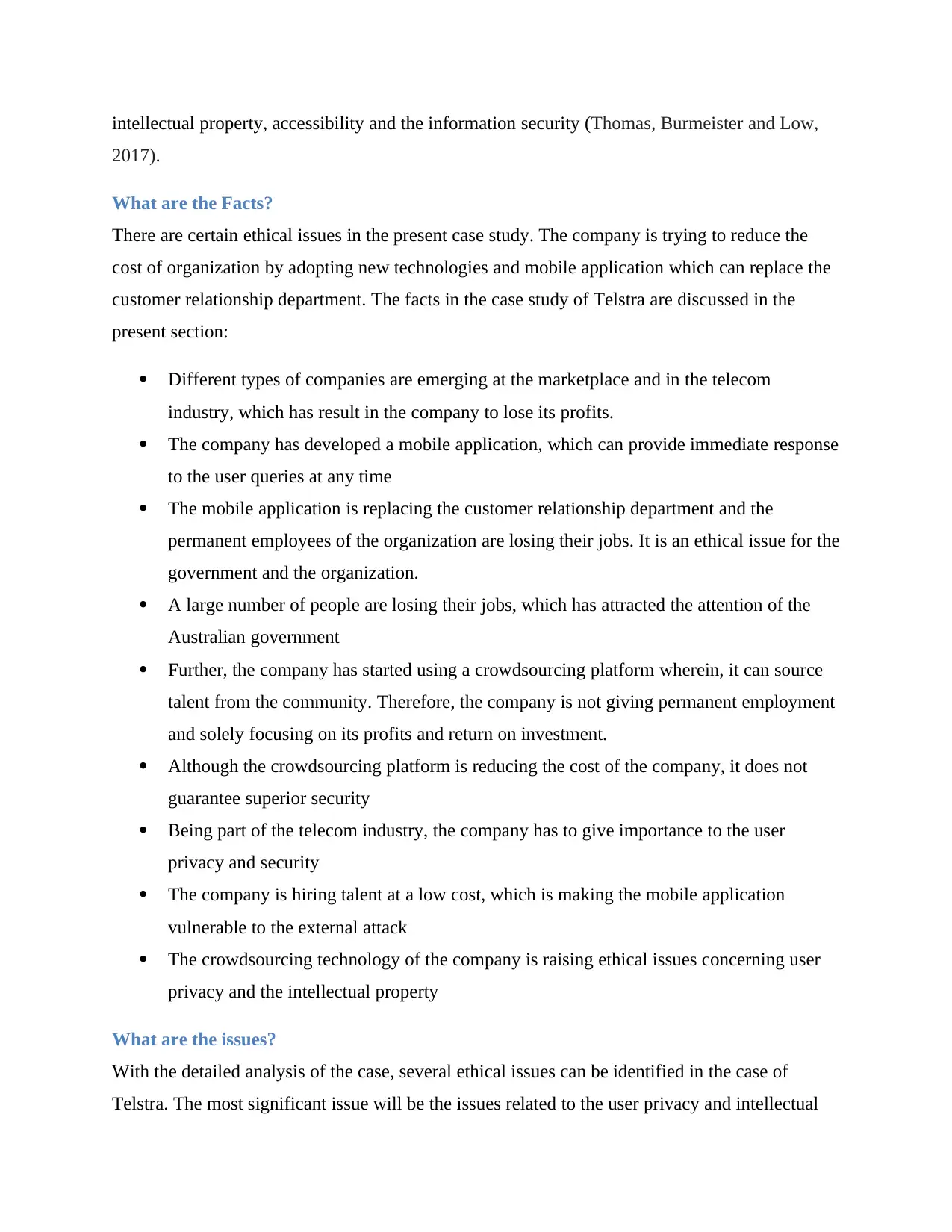
intellectual property, accessibility and the information security (Thomas, Burmeister and Low,
2017).
What are the Facts?
There are certain ethical issues in the present case study. The company is trying to reduce the
cost of organization by adopting new technologies and mobile application which can replace the
customer relationship department. The facts in the case study of Telstra are discussed in the
present section:
Different types of companies are emerging at the marketplace and in the telecom
industry, which has result in the company to lose its profits.
The company has developed a mobile application, which can provide immediate response
to the user queries at any time
The mobile application is replacing the customer relationship department and the
permanent employees of the organization are losing their jobs. It is an ethical issue for the
government and the organization.
A large number of people are losing their jobs, which has attracted the attention of the
Australian government
Further, the company has started using a crowdsourcing platform wherein, it can source
talent from the community. Therefore, the company is not giving permanent employment
and solely focusing on its profits and return on investment.
Although the crowdsourcing platform is reducing the cost of the company, it does not
guarantee superior security
Being part of the telecom industry, the company has to give importance to the user
privacy and security
The company is hiring talent at a low cost, which is making the mobile application
vulnerable to the external attack
The crowdsourcing technology of the company is raising ethical issues concerning user
privacy and the intellectual property
What are the issues?
With the detailed analysis of the case, several ethical issues can be identified in the case of
Telstra. The most significant issue will be the issues related to the user privacy and intellectual
2017).
What are the Facts?
There are certain ethical issues in the present case study. The company is trying to reduce the
cost of organization by adopting new technologies and mobile application which can replace the
customer relationship department. The facts in the case study of Telstra are discussed in the
present section:
Different types of companies are emerging at the marketplace and in the telecom
industry, which has result in the company to lose its profits.
The company has developed a mobile application, which can provide immediate response
to the user queries at any time
The mobile application is replacing the customer relationship department and the
permanent employees of the organization are losing their jobs. It is an ethical issue for the
government and the organization.
A large number of people are losing their jobs, which has attracted the attention of the
Australian government
Further, the company has started using a crowdsourcing platform wherein, it can source
talent from the community. Therefore, the company is not giving permanent employment
and solely focusing on its profits and return on investment.
Although the crowdsourcing platform is reducing the cost of the company, it does not
guarantee superior security
Being part of the telecom industry, the company has to give importance to the user
privacy and security
The company is hiring talent at a low cost, which is making the mobile application
vulnerable to the external attack
The crowdsourcing technology of the company is raising ethical issues concerning user
privacy and the intellectual property
What are the issues?
With the detailed analysis of the case, several ethical issues can be identified in the case of
Telstra. The most significant issue will be the issues related to the user privacy and intellectual
Paraphrase This Document
Need a fresh take? Get an instant paraphrase of this document with our AI Paraphraser
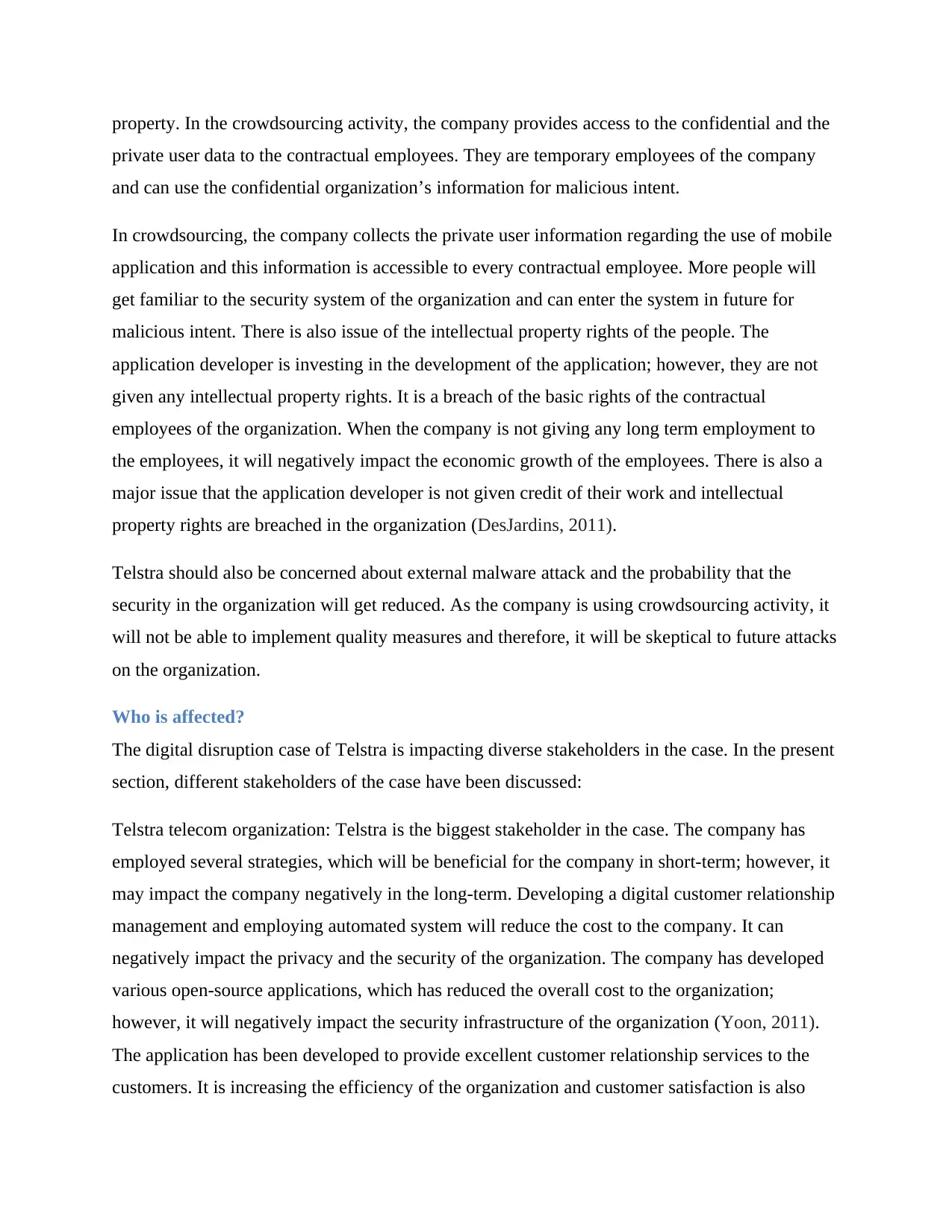
property. In the crowdsourcing activity, the company provides access to the confidential and the
private user data to the contractual employees. They are temporary employees of the company
and can use the confidential organization’s information for malicious intent.
In crowdsourcing, the company collects the private user information regarding the use of mobile
application and this information is accessible to every contractual employee. More people will
get familiar to the security system of the organization and can enter the system in future for
malicious intent. There is also issue of the intellectual property rights of the people. The
application developer is investing in the development of the application; however, they are not
given any intellectual property rights. It is a breach of the basic rights of the contractual
employees of the organization. When the company is not giving any long term employment to
the employees, it will negatively impact the economic growth of the employees. There is also a
major issue that the application developer is not given credit of their work and intellectual
property rights are breached in the organization (DesJardins, 2011).
Telstra should also be concerned about external malware attack and the probability that the
security in the organization will get reduced. As the company is using crowdsourcing activity, it
will not be able to implement quality measures and therefore, it will be skeptical to future attacks
on the organization.
Who is affected?
The digital disruption case of Telstra is impacting diverse stakeholders in the case. In the present
section, different stakeholders of the case have been discussed:
Telstra telecom organization: Telstra is the biggest stakeholder in the case. The company has
employed several strategies, which will be beneficial for the company in short-term; however, it
may impact the company negatively in the long-term. Developing a digital customer relationship
management and employing automated system will reduce the cost to the company. It can
negatively impact the privacy and the security of the organization. The company has developed
various open-source applications, which has reduced the overall cost to the organization;
however, it will negatively impact the security infrastructure of the organization (Yoon, 2011).
The application has been developed to provide excellent customer relationship services to the
customers. It is increasing the efficiency of the organization and customer satisfaction is also
private user data to the contractual employees. They are temporary employees of the company
and can use the confidential organization’s information for malicious intent.
In crowdsourcing, the company collects the private user information regarding the use of mobile
application and this information is accessible to every contractual employee. More people will
get familiar to the security system of the organization and can enter the system in future for
malicious intent. There is also issue of the intellectual property rights of the people. The
application developer is investing in the development of the application; however, they are not
given any intellectual property rights. It is a breach of the basic rights of the contractual
employees of the organization. When the company is not giving any long term employment to
the employees, it will negatively impact the economic growth of the employees. There is also a
major issue that the application developer is not given credit of their work and intellectual
property rights are breached in the organization (DesJardins, 2011).
Telstra should also be concerned about external malware attack and the probability that the
security in the organization will get reduced. As the company is using crowdsourcing activity, it
will not be able to implement quality measures and therefore, it will be skeptical to future attacks
on the organization.
Who is affected?
The digital disruption case of Telstra is impacting diverse stakeholders in the case. In the present
section, different stakeholders of the case have been discussed:
Telstra telecom organization: Telstra is the biggest stakeholder in the case. The company has
employed several strategies, which will be beneficial for the company in short-term; however, it
may impact the company negatively in the long-term. Developing a digital customer relationship
management and employing automated system will reduce the cost to the company. It can
negatively impact the privacy and the security of the organization. The company has developed
various open-source applications, which has reduced the overall cost to the organization;
however, it will negatively impact the security infrastructure of the organization (Yoon, 2011).
The application has been developed to provide excellent customer relationship services to the
customers. It is increasing the efficiency of the organization and customer satisfaction is also
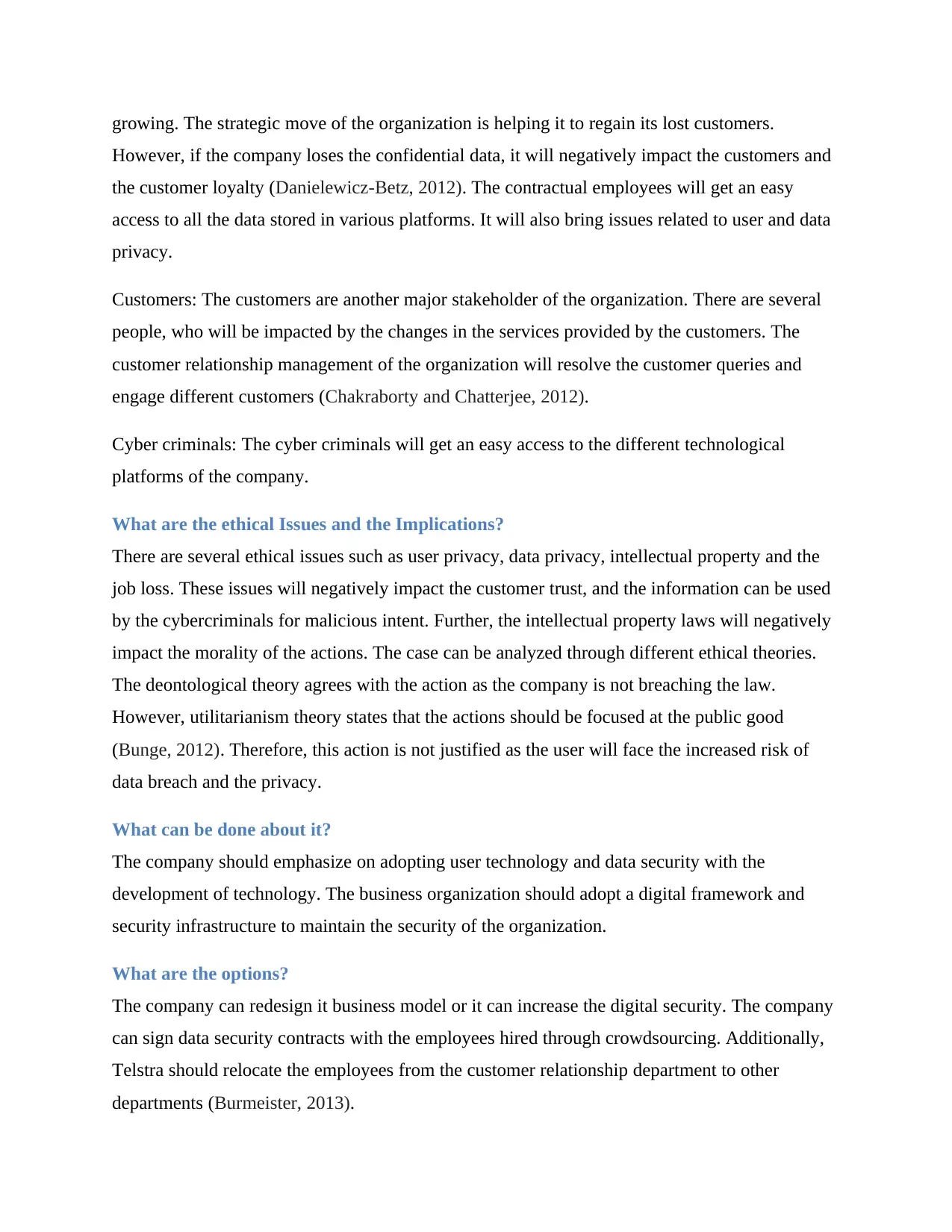
growing. The strategic move of the organization is helping it to regain its lost customers.
However, if the company loses the confidential data, it will negatively impact the customers and
the customer loyalty (Danielewicz-Betz, 2012). The contractual employees will get an easy
access to all the data stored in various platforms. It will also bring issues related to user and data
privacy.
Customers: The customers are another major stakeholder of the organization. There are several
people, who will be impacted by the changes in the services provided by the customers. The
customer relationship management of the organization will resolve the customer queries and
engage different customers (Chakraborty and Chatterjee, 2012).
Cyber criminals: The cyber criminals will get an easy access to the different technological
platforms of the company.
What are the ethical Issues and the Implications?
There are several ethical issues such as user privacy, data privacy, intellectual property and the
job loss. These issues will negatively impact the customer trust, and the information can be used
by the cybercriminals for malicious intent. Further, the intellectual property laws will negatively
impact the morality of the actions. The case can be analyzed through different ethical theories.
The deontological theory agrees with the action as the company is not breaching the law.
However, utilitarianism theory states that the actions should be focused at the public good
(Bunge, 2012). Therefore, this action is not justified as the user will face the increased risk of
data breach and the privacy.
What can be done about it?
The company should emphasize on adopting user technology and data security with the
development of technology. The business organization should adopt a digital framework and
security infrastructure to maintain the security of the organization.
What are the options?
The company can redesign it business model or it can increase the digital security. The company
can sign data security contracts with the employees hired through crowdsourcing. Additionally,
Telstra should relocate the employees from the customer relationship department to other
departments (Burmeister, 2013).
However, if the company loses the confidential data, it will negatively impact the customers and
the customer loyalty (Danielewicz-Betz, 2012). The contractual employees will get an easy
access to all the data stored in various platforms. It will also bring issues related to user and data
privacy.
Customers: The customers are another major stakeholder of the organization. There are several
people, who will be impacted by the changes in the services provided by the customers. The
customer relationship management of the organization will resolve the customer queries and
engage different customers (Chakraborty and Chatterjee, 2012).
Cyber criminals: The cyber criminals will get an easy access to the different technological
platforms of the company.
What are the ethical Issues and the Implications?
There are several ethical issues such as user privacy, data privacy, intellectual property and the
job loss. These issues will negatively impact the customer trust, and the information can be used
by the cybercriminals for malicious intent. Further, the intellectual property laws will negatively
impact the morality of the actions. The case can be analyzed through different ethical theories.
The deontological theory agrees with the action as the company is not breaching the law.
However, utilitarianism theory states that the actions should be focused at the public good
(Bunge, 2012). Therefore, this action is not justified as the user will face the increased risk of
data breach and the privacy.
What can be done about it?
The company should emphasize on adopting user technology and data security with the
development of technology. The business organization should adopt a digital framework and
security infrastructure to maintain the security of the organization.
What are the options?
The company can redesign it business model or it can increase the digital security. The company
can sign data security contracts with the employees hired through crowdsourcing. Additionally,
Telstra should relocate the employees from the customer relationship department to other
departments (Burmeister, 2013).
⊘ This is a preview!⊘
Do you want full access?
Subscribe today to unlock all pages.

Trusted by 1+ million students worldwide
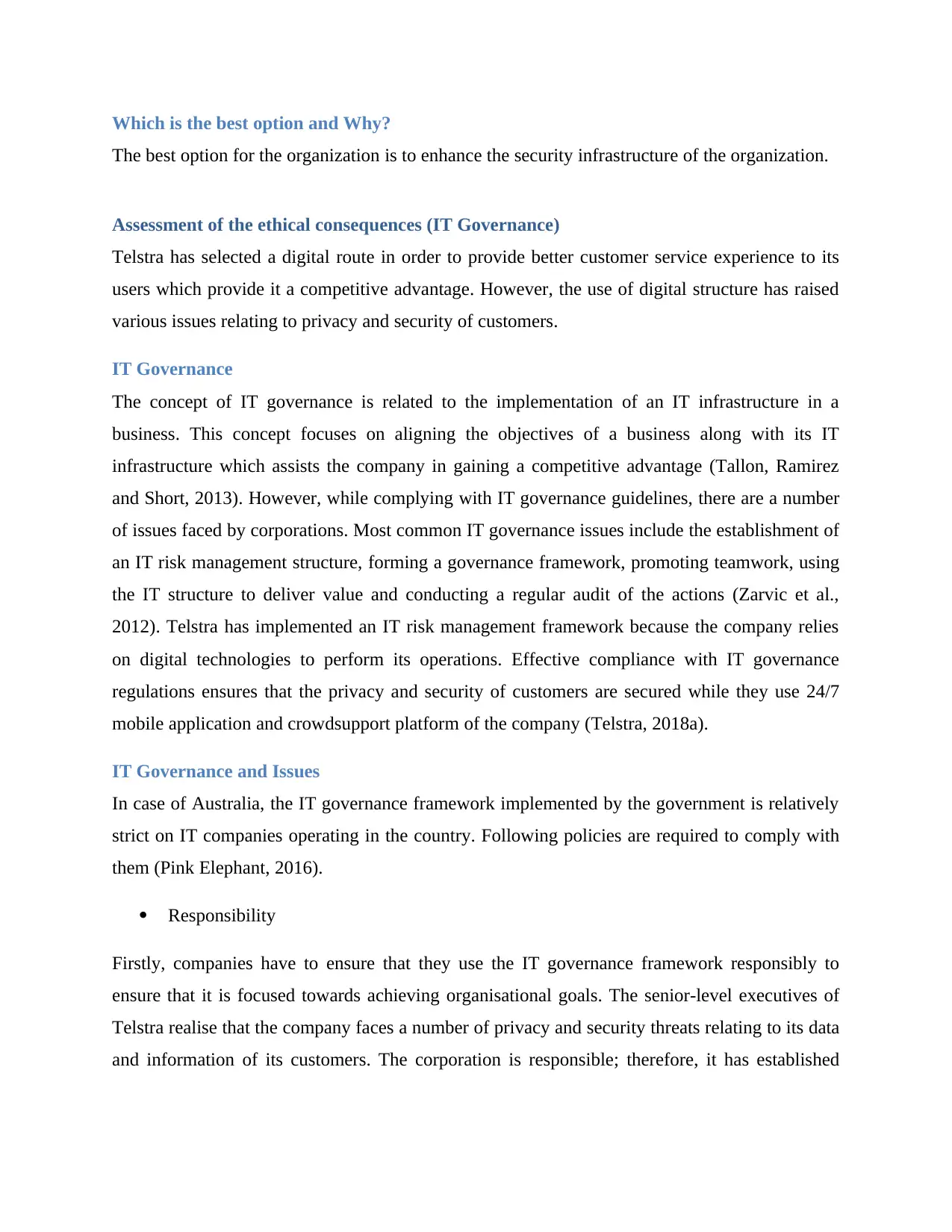
Which is the best option and Why?
The best option for the organization is to enhance the security infrastructure of the organization.
Assessment of the ethical consequences (IT Governance)
Telstra has selected a digital route in order to provide better customer service experience to its
users which provide it a competitive advantage. However, the use of digital structure has raised
various issues relating to privacy and security of customers.
IT Governance
The concept of IT governance is related to the implementation of an IT infrastructure in a
business. This concept focuses on aligning the objectives of a business along with its IT
infrastructure which assists the company in gaining a competitive advantage (Tallon, Ramirez
and Short, 2013). However, while complying with IT governance guidelines, there are a number
of issues faced by corporations. Most common IT governance issues include the establishment of
an IT risk management structure, forming a governance framework, promoting teamwork, using
the IT structure to deliver value and conducting a regular audit of the actions (Zarvic et al.,
2012). Telstra has implemented an IT risk management framework because the company relies
on digital technologies to perform its operations. Effective compliance with IT governance
regulations ensures that the privacy and security of customers are secured while they use 24/7
mobile application and crowdsupport platform of the company (Telstra, 2018a).
IT Governance and Issues
In case of Australia, the IT governance framework implemented by the government is relatively
strict on IT companies operating in the country. Following policies are required to comply with
them (Pink Elephant, 2016).
Responsibility
Firstly, companies have to ensure that they use the IT governance framework responsibly to
ensure that it is focused towards achieving organisational goals. The senior-level executives of
Telstra realise that the company faces a number of privacy and security threats relating to its data
and information of its customers. The corporation is responsible; therefore, it has established
The best option for the organization is to enhance the security infrastructure of the organization.
Assessment of the ethical consequences (IT Governance)
Telstra has selected a digital route in order to provide better customer service experience to its
users which provide it a competitive advantage. However, the use of digital structure has raised
various issues relating to privacy and security of customers.
IT Governance
The concept of IT governance is related to the implementation of an IT infrastructure in a
business. This concept focuses on aligning the objectives of a business along with its IT
infrastructure which assists the company in gaining a competitive advantage (Tallon, Ramirez
and Short, 2013). However, while complying with IT governance guidelines, there are a number
of issues faced by corporations. Most common IT governance issues include the establishment of
an IT risk management structure, forming a governance framework, promoting teamwork, using
the IT structure to deliver value and conducting a regular audit of the actions (Zarvic et al.,
2012). Telstra has implemented an IT risk management framework because the company relies
on digital technologies to perform its operations. Effective compliance with IT governance
regulations ensures that the privacy and security of customers are secured while they use 24/7
mobile application and crowdsupport platform of the company (Telstra, 2018a).
IT Governance and Issues
In case of Australia, the IT governance framework implemented by the government is relatively
strict on IT companies operating in the country. Following policies are required to comply with
them (Pink Elephant, 2016).
Responsibility
Firstly, companies have to ensure that they use the IT governance framework responsibly to
ensure that it is focused towards achieving organisational goals. The senior-level executives of
Telstra realise that the company faces a number of privacy and security threats relating to its data
and information of its customers. The corporation is responsible; therefore, it has established
Paraphrase This Document
Need a fresh take? Get an instant paraphrase of this document with our AI Paraphraser
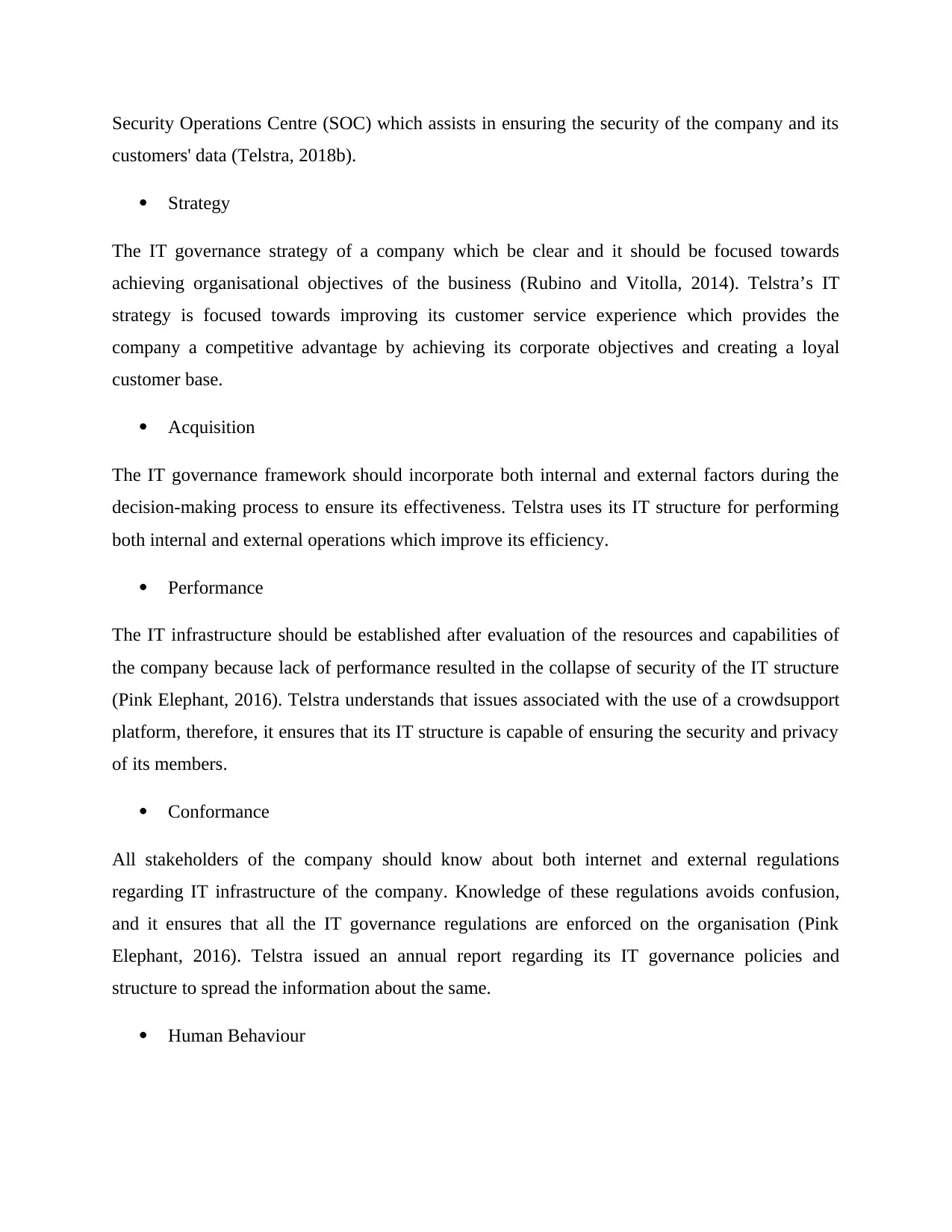
Security Operations Centre (SOC) which assists in ensuring the security of the company and its
customers' data (Telstra, 2018b).
Strategy
The IT governance strategy of a company which be clear and it should be focused towards
achieving organisational objectives of the business (Rubino and Vitolla, 2014). Telstra’s IT
strategy is focused towards improving its customer service experience which provides the
company a competitive advantage by achieving its corporate objectives and creating a loyal
customer base.
Acquisition
The IT governance framework should incorporate both internal and external factors during the
decision-making process to ensure its effectiveness. Telstra uses its IT structure for performing
both internal and external operations which improve its efficiency.
Performance
The IT infrastructure should be established after evaluation of the resources and capabilities of
the company because lack of performance resulted in the collapse of security of the IT structure
(Pink Elephant, 2016). Telstra understands that issues associated with the use of a crowdsupport
platform, therefore, it ensures that its IT structure is capable of ensuring the security and privacy
of its members.
Conformance
All stakeholders of the company should know about both internet and external regulations
regarding IT infrastructure of the company. Knowledge of these regulations avoids confusion,
and it ensures that all the IT governance regulations are enforced on the organisation (Pink
Elephant, 2016). Telstra issued an annual report regarding its IT governance policies and
structure to spread the information about the same.
Human Behaviour
customers' data (Telstra, 2018b).
Strategy
The IT governance strategy of a company which be clear and it should be focused towards
achieving organisational objectives of the business (Rubino and Vitolla, 2014). Telstra’s IT
strategy is focused towards improving its customer service experience which provides the
company a competitive advantage by achieving its corporate objectives and creating a loyal
customer base.
Acquisition
The IT governance framework should incorporate both internal and external factors during the
decision-making process to ensure its effectiveness. Telstra uses its IT structure for performing
both internal and external operations which improve its efficiency.
Performance
The IT infrastructure should be established after evaluation of the resources and capabilities of
the company because lack of performance resulted in the collapse of security of the IT structure
(Pink Elephant, 2016). Telstra understands that issues associated with the use of a crowdsupport
platform, therefore, it ensures that its IT structure is capable of ensuring the security and privacy
of its members.
Conformance
All stakeholders of the company should know about both internet and external regulations
regarding IT infrastructure of the company. Knowledge of these regulations avoids confusion,
and it ensures that all the IT governance regulations are enforced on the organisation (Pink
Elephant, 2016). Telstra issued an annual report regarding its IT governance policies and
structure to spread the information about the same.
Human Behaviour
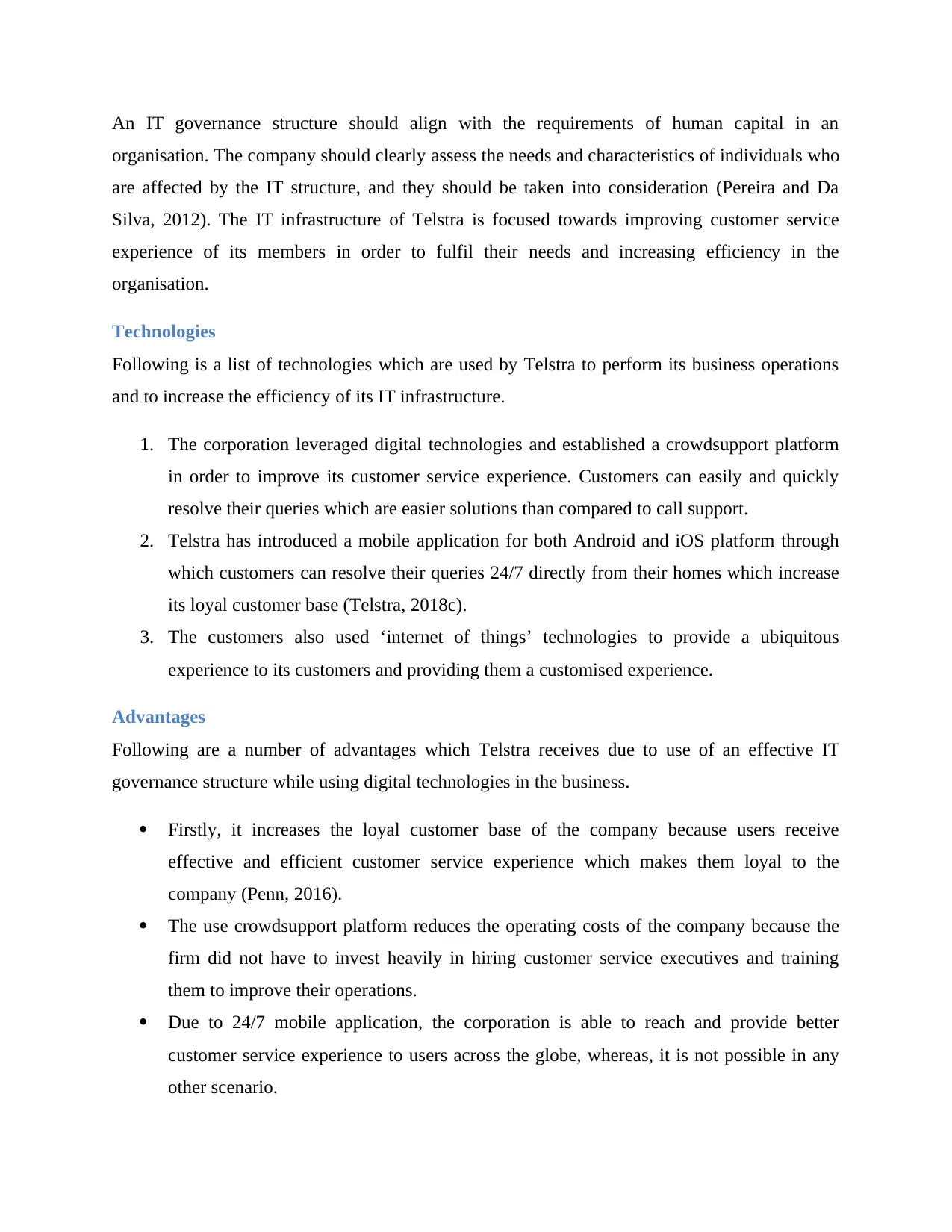
An IT governance structure should align with the requirements of human capital in an
organisation. The company should clearly assess the needs and characteristics of individuals who
are affected by the IT structure, and they should be taken into consideration (Pereira and Da
Silva, 2012). The IT infrastructure of Telstra is focused towards improving customer service
experience of its members in order to fulfil their needs and increasing efficiency in the
organisation.
Technologies
Following is a list of technologies which are used by Telstra to perform its business operations
and to increase the efficiency of its IT infrastructure.
1. The corporation leveraged digital technologies and established a crowdsupport platform
in order to improve its customer service experience. Customers can easily and quickly
resolve their queries which are easier solutions than compared to call support.
2. Telstra has introduced a mobile application for both Android and iOS platform through
which customers can resolve their queries 24/7 directly from their homes which increase
its loyal customer base (Telstra, 2018c).
3. The customers also used ‘internet of things’ technologies to provide a ubiquitous
experience to its customers and providing them a customised experience.
Advantages
Following are a number of advantages which Telstra receives due to use of an effective IT
governance structure while using digital technologies in the business.
Firstly, it increases the loyal customer base of the company because users receive
effective and efficient customer service experience which makes them loyal to the
company (Penn, 2016).
The use crowdsupport platform reduces the operating costs of the company because the
firm did not have to invest heavily in hiring customer service executives and training
them to improve their operations.
Due to 24/7 mobile application, the corporation is able to reach and provide better
customer service experience to users across the globe, whereas, it is not possible in any
other scenario.
organisation. The company should clearly assess the needs and characteristics of individuals who
are affected by the IT structure, and they should be taken into consideration (Pereira and Da
Silva, 2012). The IT infrastructure of Telstra is focused towards improving customer service
experience of its members in order to fulfil their needs and increasing efficiency in the
organisation.
Technologies
Following is a list of technologies which are used by Telstra to perform its business operations
and to increase the efficiency of its IT infrastructure.
1. The corporation leveraged digital technologies and established a crowdsupport platform
in order to improve its customer service experience. Customers can easily and quickly
resolve their queries which are easier solutions than compared to call support.
2. Telstra has introduced a mobile application for both Android and iOS platform through
which customers can resolve their queries 24/7 directly from their homes which increase
its loyal customer base (Telstra, 2018c).
3. The customers also used ‘internet of things’ technologies to provide a ubiquitous
experience to its customers and providing them a customised experience.
Advantages
Following are a number of advantages which Telstra receives due to use of an effective IT
governance structure while using digital technologies in the business.
Firstly, it increases the loyal customer base of the company because users receive
effective and efficient customer service experience which makes them loyal to the
company (Penn, 2016).
The use crowdsupport platform reduces the operating costs of the company because the
firm did not have to invest heavily in hiring customer service executives and training
them to improve their operations.
Due to 24/7 mobile application, the corporation is able to reach and provide better
customer service experience to users across the globe, whereas, it is not possible in any
other scenario.
⊘ This is a preview!⊘
Do you want full access?
Subscribe today to unlock all pages.

Trusted by 1+ million students worldwide
1 out of 16
Related Documents
Your All-in-One AI-Powered Toolkit for Academic Success.
+13062052269
info@desklib.com
Available 24*7 on WhatsApp / Email
![[object Object]](/_next/static/media/star-bottom.7253800d.svg)
Unlock your academic potential
Copyright © 2020–2025 A2Z Services. All Rights Reserved. Developed and managed by ZUCOL.





